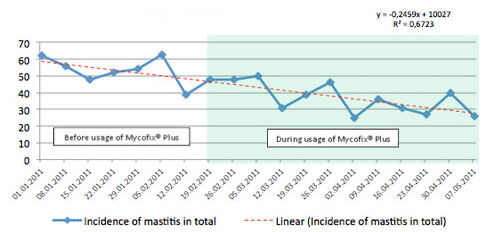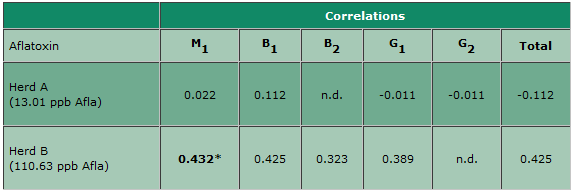



Mycotoxins: Serious Threat to Dairy Industry
The contamination of animal feed with mycotoxins is a worldwide problem in animal production. The complex diet of ruminants, consisting of forages, concentrates, and silages, can be a source of diverse mixtures of mycotoxins that contaminate individual feed components.Concomitantly, there has been an increase in feed intake to meet the greater nutrient demand, which often exposes cows to mycotoxin contaminated feeds. Dairy cows, like other ruminants, have some capacity to protect themselves against the harmful effects of mycotoxins due to the detoxifying action of certain rumenal microorganisms.
However, modern dairy cows have a much faster passage of feed through the rumen thus less time for rumen microbes to detoxify mycotoxins. The combined factors of high production, incompetent rumen microflora action, unbalanced nutrition (ex. subclinical acidosis) and mycotoxins in the feed are key factors allowing mycotoxins to escape detoxification and be absorbed by the intestine as in monogastrics. Symptoms of mycotoxicosis in a dairy herd may be non-specific, wide ranging and sub-clinical depending on the mycotoxins involved and their interaction with other stress factors as farm management, presence of infectious diseases and welfare of the animals.
Diagnosis of mycotoxicoses in ruminants
Recognizing when mycotoxins are causing poor health and performance is extremely difficult. Some mycotoxins, such as zearalenone, predominantly affect reproduction and are relatively easy to identify. Also, high levels of mycotoxins that can cause acute intoxications and dramatic changes in milk production and animal health status can be determined much more easily. Unfortunately, the most common and most difficult challenges to identify occur when rations contain low levels of mycotoxins and the health effects are subclinical. Presence of mycotoxins in feed is very often connected with increased incidence of metabolic disorders as ketosis, retained placentas, displaced abomasums, mastitis, metritis, lameness, elevated somatic cell counts and consequently slightly decreased milk production. Subclinical mycotoxicoses decrease profitability by lowering milk production and quality and finally increasing expenses from inappropriate veterinary therapies.
Mode of action
Mycotoxins can be the primary agent causing acute health or production problems in a dairy herd, but more likely, mycotoxins are a factor contributing to chronic problems including a higher incidence of diseases, poor reproductive performance or suboptimal milk production. They exert their effects through four primary mechanisms: (1) intake reduction or feed refusal, (2) reduced nutrient absorption and impaired metabolism; (3) alterations in the endocrine and exocrine systems; and (4) suppression of the immune system. Recognition of the impact of mycotoxins on animal production has been limited by the difficulty of diagnosis. Symptoms are often nonspecific and the result of a progression of effects, making a diagnosis difficult or impossible because of the complex clinical results with a wide diversity of symptoms.
Mastitis and metritis incidence in presence of mycotoxins
Mastitis is defined as an inflammation of the mammary gland. Mastitis usually occurs primarily in response to intramammary bacterial infection, but also to intramammary mycoplasmal, fungal, or algal infections. Mechanical trauma, thermal trauma, and chemical insult predispose the gland to intramammary infection. Occurrence of mastitis depends on the interaction of host, agent, and environmental factors (Zhao and Lacasse, 2007). Metritis is defined as inflammation of both the endometrial and muscular layers of the uterus. Risk factors for developing postpartum metritis are: retained placenta, dystocia, stillbirth, twinning, uterine prolapsed, milk fever, poor hygiene during calving, ketosis etc. (Palmer, 2003). Results from the dairy farm with 3200 dairy cows, 3000 heifers and 400 calves show that average decrease in mastitis and metritis incidence after usage of Mycofix® Plus (15 – 30 g/cow/day) was -30.3 % and -32.5 %, respectively (Figure 1 and 2). Mycotoxin contamination of TMR was 800 ppb of deoxynivalenol and 38 ppb of zearalenone.
Incidence of Mastitis in Total

Incidence of Metritis in Total

Lameness incidence in presence of mycotoxins
Another aspect that should be taken into account is the higher incidence of lameness on dairy farms feeding rations contaminated with mycotoxins. Lameness alone in dairy farms already causes large financial losses due to a decreased milk production, impaired reproductive performance and higher culling and veterinary costs. In a study conducted in 2010 by Pirestani and Toghyani it is proved that increase in the levels of aflatoxin (from 13.01 to 110.63 ppb) concentration in the feedstuff was responsible for the increase in aflatoxin M1 in milk samples. Also, levels of aflatoxin in diet and milk caused retained placenta which is a reproduction problem (delayed conception). Prevalence of lameness was significantly affected by milk aflatoxin level (P ? 0.05). It was concluded that there was a significant relationship between aflatoxin levels with lameness and retained placenta.
The Rank Correlation Between Aflatoxin and Lameness in Dairy Farms

There was a significant relationship between aflatoxin and lameness (Table 1). This might be due to the aflatoxin and its effect on the sensitive lamina hoof, unsuitably placed straw yards, nutrition and poor management. In addition comparisons between normal cattle and lame cattle showed a slightly longer interval between calving to first insemination and conception in lame cattle. This difference may be related to the pain caused by lameness associated with aflatoxins, which results in reduced feed intake and thus lower energy intake, hormonal and nutrition imbalance (Ozsoy‘s et al., 2005; Sood and Nanda, 2006). Korosteleva et al. (2009) observed that 500 ppb of deoxynivalenol may also reduce phagocytic and neutrophilic activity and consequently determine serious symptoms when mastitis and lameness occurs. Lameness is one of the most predominant clinical signs of ergot alkaloid poisoning together with reduced weight gain and agalactia (Whitlow, 1993).
Conclusion
It is well known fact that almost all mycotoxins suppress the immune system and impair a proper rumen function, even at levels that may not cause metabolic or physiological problems. It is essential to realize that mycotoxins decrease the feed intake which is consequently leading to decreased milk production. Accurate feeding of dairy cows in combination with continuous mycotoxin risk management is the key in managing the optimal performance of the livestock business.
April 2012



